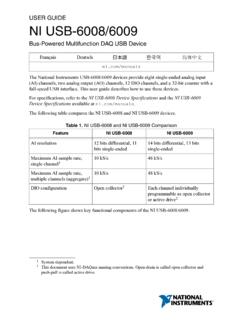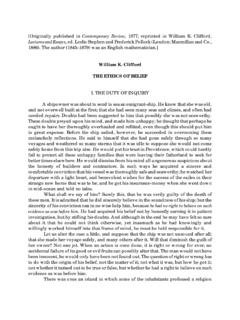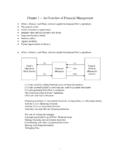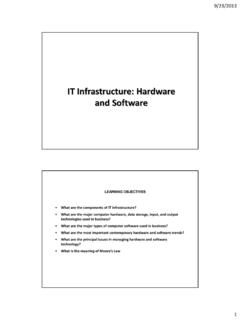Transcription of Stephen A. Ross, Randolph W. Westerfield, Jeffrey Jaffe
1 Study notes By Zhipeng Yan corporate Finance Stephen A. Ross, Randolph W. Westerfield, Jeffrey Jaffe Chapter 1 Introduction to corporate Finance .. 2. Chapter 2 Accounting Statements and Cash 3. Chapter 3 Financial Markets and NPV: First Principles of 6. Chapter 4 Net Present 6. Chapter 5 How to Value Bonds and 7. Chapter 6 Some Alternative Investment 8. Chapter 7 NPV and Capital 9. Chapter 8 Strategy and Analysis in Using NPV .. 10. Chapter 9 Capital Market Theory .. 10. Chapter 10 Return and Risk: CAPM .. 10. Chapter 11 An Alternative View of Risk and Return: APT .. 11. Chapter 12 Risk, cost of Capital, and Capital Budget .. 13. Chapter 13 corporate -financing Decisions and Efficient Capital 15. Chapter 14 Long-Term Financing: An 18. Chapter 15 Capital Structure: Basic 20. Chapter 16 Capital Structure: Limits to the Use of 21.
2 Chapter 17 Valuation and Capital Budgeting for the Levered 26. Chapter 18 Dividend policy: Why Does it Matter? .. 27. Chapter 19 Issuing Securities to the Public .. 31. Chapter 20 Long-Term 37. Chapter 21 Leasing .. 41. Chapter 22 Options and corporate Finance: Basic 45. Chapter 23 Options and corporate Finance: Extensions and 47. Chapter 24 Warrants and Convertibles .. 49. Chapter 25 Derivatives and Hedging 51. Chapter 30 Mergers and 53. Chapter 31 Financial Distress .. 57. 1. Study notes By Zhipeng Yan Chapter 1 Introduction to corporate Finance 1. Balance-sheet model of the firm: I. left-hand side of the sheet: in what long-lived assets should the firm invest? capital budget. II. Right-hand side: how can the firm raise cash for required capital expenditures? capital structure. III. Net working capital = current asset current liabilities: how should short-term operating cash flows be managed?
3 2. a firm sold gold for $10 and has yet to collect from the customer. The cost is $9: Income statement: Accounting view: profit = 10-9=1. corporate finance view: cash inflow = 0; cash outflow = -9. 3. the sole proprietorship\. I. it is the cheapest business to form. II. It pays no corporate income taxes. All profits of the business are taxed as individual income. III. It has unlimited liability for business debts and obligations. No distinction is made b/w personal and business assets. 4. the partnership: I. Partnerships are usually inexpensive and easy to form. II. General partners have unlimited liability for all debts. The general partnership is terminated when a general partner dies or withdraws. It is difficult for a partnership to transfer ownership without dissolving. The advantage is the cost of getting started.
4 The disadvantages are: 1) unlimited liability, 2) limited life of the enterprise, and 3) difficulty of transferring ownership. These three disadvantages lead to 4) the difficulty of raising cash. 5. the corporation: limited liability, ease of ownership transfer, and perpetual succession are the major advantages; Disadvantage: government taxes corporate income. 6. agency costs: the cost of resolving the conflicts of interest b/w managers and shareholders are special types of costs. Residual losses are the lost wealth of the shareholders due to divergent behavior of the managers. 7. G. Donaldson concluded that managers are influenced by two basic motivations: I. survival. II. Independence and self-sufficiency: this is the freedom to make decisions without encountering external parties or depending on outside financial markets.
5 The Donaldson interviews suggested that managers do not like to issue new shares of stock. Instead, they like to be able to rely on internally generated cash flow. III. Therefore, the basic financial objective of managers: the maximization of corporate wealth. corporate wealth is that wealth over which management has effective control. corporate wealth is not necessarily shareholder wealth. 2. Study notes By Zhipeng Yan 8. several control devices used by shareholders bond management to the self-interest of shareholders: I. shareholders control the directors, who in turn select the management team;. II. contracts with management and arrangements for compensation, such as stock option plans, can be made so that management has an incentive to pursue the goal of the shareholders. III. Fear of a takeover gives managers an incentive to take actions that will maximize stock prices.
6 IV. Competition in the managerial labor market may force managers to perform in the best interest of stockholders. The available evidence and theory are consistent with the ideas of shareholder control and shareholder value maximization. 9. Secondary markets: I. Auction market: the equity securities of most large US firms trade in organized auction markets. NYSE. II. Most debt securities are traded in dealer markets. Some stocks are traded in the dealer markets. When they are, it is referred to as the OTC market. NASDAQ. Chapter 2 Accounting Statements and Cash Flow 1. Balance sheet: I. The assets in the balance sheet are listed in order by the length of time it normally would take an ongoing firm to convert them to cash. II. The liabilities and the stockholders' equity are listed in the order in which they must be paid.
7 Assets Liabilities and Stockholders' equity Current assets Current liabilities cash and equivalents account payable accounts receivable notes payable inventories and other accrued expenses Total current assets Total current liabilities Fixed assets Long-term liabilities property, plant and equipment deferred taxes Less accumulated depreciation Long-term debt Net property, plant and equipment Total Long-term liabilities intangible assets and others Stockholders' equity Total fixed assets preferred stock common stock capital surplus accumulated retained earnings Less treasury stock Total equity Total assets Total Liabilities and Stockholders'. 3. Study notes By Zhipeng Yan equity III. The more liquid a firm's assets, the less likely the firm is to experience problems meeting short-term obligations. But liquid assets frequently have lower rates of return than fixed assets.
8 2. Income statement: Income statement Total operating revenues (cost of goods sold). (selling, general, and administrative expenses). (depreciation). Operating income Other income Earnings before interest and taxes (EBIT). (Interest expense). Pretax tax income (Taxes). Current: Deferred: Net income Retained earnings: Dividends: 3. noncash items: depreciation and deferred taxes. They appear in income statement according to GAAP, but they are not cash outflows. 4. the statement of cash flows: helps to explain the change in accounting cash and equivalents. Statement of cash flows Operations Net income Depreciation Deferred taxes Changes in current assets and liabilities (other than cash). Total cash flow from operations Investing activities Acquisition of fixed assets Sales of fixed assets Total cash flow from investing activities Total cash flow from Financing activities Change in cash ( on the balance sheet).
9 The difference b/w cash flow from Financing activities and total cash flow of the firm is interest expense. 5. the cash flows generated from the firm's assets = the cash flows to the firm's creditors and equity investors. 4. Study notes By Zhipeng Yan CASH FLOW(A) = CASH FLOW(B) + CASH FLOW(S). Financial Cash flow/ free cash flow / total cash flow Cash flow of the firm Cash flow to investors in the firm Operating cash flow (EBIT + depreciation Debt (interest + retirement of debt . taxes) long-term debt financing). (Capital spending) (acquisitions of fixed Equity (dividends + repurchase of equity assets - sales of fixed assets) new equity financing). (addition to net working capital). Total ======================= Total 6. Financial ratios: I. short-term solvency: the ability of the firm to meet its short-run obligations.
10 A. current ratio = total current assets/ total current liabilities. b. Quick ratio = quick assets/ total current liabilities. II. activity: the ability of the firm to control its investment in assets. The idea is to find out how effectively assets are used to generate sales. a. total asset turnover = total operating revenues/ total assets(average). b. receivables turnover = total operating revenues/Receivables (average). average collection period = Days in period/Receivables turnover c. inventory turnover = cost of goods sold/inventory(average). days in inventory = Days in period/inventory turnover III. Financial leverage: the extent to which a firm relies on debt financing. a. debt ratios: debt ratio = debt/assets; debt-to-equity ratio;. equity multiplier = assets/ equity. b. Interest coverage = EBIT/ interest expense IV.

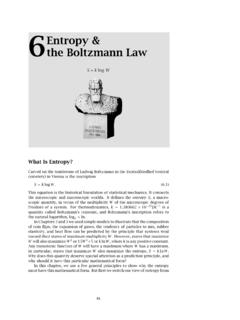




![LINEAR ALGEBRA MIDTERM [EXAM A] - Brandeis University](/cache/preview/2/a/5/a/8/6/f/b/thumb-2a5a86fbead498bbe4749596c75df645.jpg)
